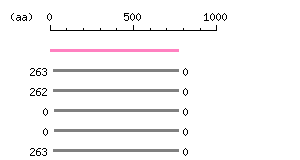
| HUGE |
Gene/Protein Characteristic Table for KIAA1372 |
|
Link to :
Rouge |
GTOP | SWISS-PROT/TrEMBL | GeneCards| RefDIC | |
| Features : DNA sequence | Protein sequence | Expression | Mapping | |
| Product ID : | ORK00220 |
|---|---|
| Accession No. : | AB037793 |
| Description : | Ubiquitin carboxyl-terminal hydrolase 35. |
| HUGO Gene Name : | ubiquitin specific peptidase 35 (USP35) |
| Clone Name : | fj03335 [Vector Info] |
| Flexi ORF Clone : | pF1KA1372
 |
| Source : | Human fetal brain |
Features of the cloned DNA sequence |
Description | |
|---|---|---|
Length: 3771 bp

|
| cloned DNA seq. | |
Warning for N-terminal truncation: | NO |
Warning for coding interruption: | NO |
Length of 3'UTR 895 bp Genome contig ID gi51511727f_77487664 PolyA signal sequence
(AATAAA,-19)
CCCATGTTCATAAATAAATAAAAGTAAGCCTAAGCFlanking genome sequence
(115739 - 115788)
AAGAGATTGTTCTTCCTTGGACTCAGGGGCTGTGATGGCCACTGGGTTTT
Chr f/r start end exon identity class ContigView(URL based/DAS) 11 f 77587664 77603401 8 99.7 Perfect prediction
Features of the protein sequence |
Description | |
|---|---|---|
Length: 773 aa
 |
|
The numbers on the left and right sides of a black line in the graphical overview indicate the lengths (in amino acid residues) of the non-homologous N-terminal and C-terminal portions flanking the homologous region (indicated by the black line), respectively.
 |
|
The numbers on the left and right sides of a black line in the graphical overview indicate the lengths (in amino acid residues) of the non-homologous N-terminal and C-terminal portions flanking the homologous region (indicated by the black line), respectively.

Expression profile |
Description | |
|---|---|---|
| RT-PCR-ELISA | Description |
|---|

Experimental conditions
| : GTATCCCCCTTGTGGTTAGAG | |
| : ACAAAGGCCAACTGCTCAGAG | |
| : 95 °C |
RH mapping information |
Description | |
|---|---|---|
| : 11 |
| : GeneBridge 4 | |
| : CTTCTCTTTCGACCTGCGCAC | |
| : CATAGCAGTAGTAGTGACCAC | |
| : 170 bp | |
| : 95 °C |
|
How to obtain KIAA clone(s) Back to the HUGE Protein Database homepage 
| |